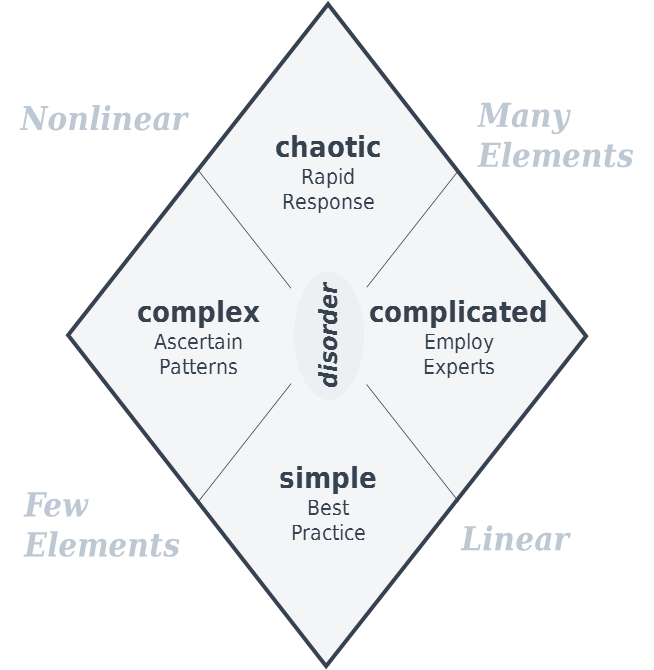
| Home | FAQs | Book Contents | Updates & News | Downloads |

Political and business leaders are often remembered for a one spectacular failure which has overshadowed a lifetime of serene success. According to one study♯ those occasions often arise when the underlying situation has been misread. The authors suggest that there are four major "modes" that events can follow depending on the number of constituent elements and how predictable those elements are. When there are a small number of parts behaving in a linear way then understanding the system's behaviour is straightforward and there is usually general consensus about the "best practice": the optimal approach is usually self-evident and generally followed. If there are numerous components each of which is unpredictable then the good leader has no choice but to try something, monitor how the overall system responds and be prepared to quickly change things, even reversing a previous position, if things start to go wrong: the focus should be on monitoring and responding rapidly.
In my experience the world of business decisions in oil companies doesn't usually fall into either of those two modes, within this framework E&P activities are best thought of as being either "complex" or "complicated". Complicated situations involve interactions between many predictable components. In these cases experience is the key, there are usually a number of solutions whose outcomes are "good enough" but also some potential pitfalls for the unwary. Paying attention to experts who can foresee disaster is the key. Complex situations by contrast have responses that can't be reliably predicted even by the experts, an approach that has worked reliably in the past may turn out to be a disaster. This means that, while specialists are needed to spot the early signs of looming failure, the best approach is to try something and be prepared to respond quickly when, in this particular case, it fails to deliver the desired outcome. For leaders who want to live in a risk free world the complex situation challenges their style. They have to depend on experts, but the experts have no choice but to try something and see if it works. An executive might demand a fail-safe plan with a predicted outcome, but reality usually delivers an unexpected result. Complex situations require a more experimental approach, an ability to tolerate the unanticipated and to be flexible when the experts can see things starting to veer off course.
According to this framework leaders get comfortable working in one of these four modes and when faced with a changing situation keep doing things that would have been effective in their old environment. Of course this is too simplistic a picture to do anything more than suggest corrections, but it does sounds familiar enough to be worth thinking about.
♯ "A Leader's Framework for Decision Making" by David Snowden and Mary Boone published in the November 2007 Harvard Business Review
Article 63 |
Articles |
RSS Feed |
Updates |
Intro |
Book Contents |
All Figures |
Refs |
Downloads |
Links |
Purchase |
Contact Us |
Article 65 |